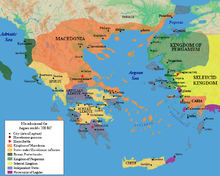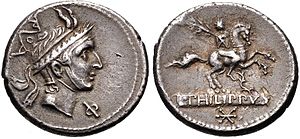Philip V of Macedon
| Philip V | |
|---|---|
Demetrius II Aetolicus | |
| Mother | Chryseis |
Philip V (Greek: Φίλιππος, romanized: Philippos; 238–179 BC) was king of the ancient Greek kingdom of Macedon from 221 to 179 BC. Philip's reign was principally marked by the Social War in Greece (220-217 BC) and a struggle with the emerging power of the Roman Republic. He would lead Macedon against Rome in the First (212-205 BC) and Second (200-196 BC) Macedonian Wars. While he lost the latter, Philip later allied with Rome against Antiochus III in the Roman-Seleucid War. He died in 179 BC from illness after efforts to recover the military and economic condition of Macedonia and passed the throne onto his elder son, Perseus of Macedon.
Early life

Philip was the son of
Philip was attractive and charismatic as a young man. A dashing and courageous warrior, he was compared to Alexander the Great, modelled himself on Philip II, and is said by Polybius to have become a universal beloved of the Greeks (κοινός τις...ἐρώμενος...τῶν Ἑλλήνων; Plb. 7.8.11) because of his benevolent conduct towards them.[3] He had a close relationship with Aratus of Sicyon, who until 213 BC held a prestigious position at his court.[4]
After ascending to the throne, in the first year of his reign Philip V pushed back the Dardani and other tribes in the north of Macedonia.[citation needed]
The Social War

The Social War (220–217 BC) began following the establishment of the Hellenic League (Symmachy) of Greek federations (eventually including the Achaeans, Acarnanians, Boeotians, Euboeans, Magnesians, Messenians, and Thessalians) was assembled in Corinth in 224 BC at the instigation of Antigonus III Doson, the uncle and predecessor of Philip V. Philip took over leadership of the Hellenic League in 221/0 BC and led the Hellenic League on a three-year war against Aetolia, Sparta and Elis. Following the sack of Thermum, the Aetolian political and religious capital, the Aetolians agreed to peace. Philip's troops destroyed 2,000 statues and hauled away vast sums of treasure which included some fifteen thousand shields and suits of arms with which the Aetolians had decorated their stoas (Plb. 5.9).[5] These shields were the arms taken from the enemies of the Aetolians during their previous military victories and included the shields of the Gauls who had raided Greece in the 3rd century BC.[6]
Philip and his Greek allies in the Hellenic League ultimately claimed victory against the Aetolians, Spartans and Elians at the conference of Naupactus in 217 BC (Plb. 5.102-105). During the war, Philip V was able to stabilise and increase his own authority amongst his own ministers and became well-known and respected for his leadership and military prowess among the Greeks (Plb. 4.77.1-4; 5.104.4-11; 7.11.4-6).
First Macedonian War (214–205 BC)

After the Peace of
In 215 BC, Philip V signed a Macedonian–Carthaginian Treaty with Hannibal Barca the Carthaginian general (Plb. 7.9; Livy 23.33, 38.7).[9] Their treaty defined spheres of operation and interest, but achieved little of substance or value for either side. Philip V became heavily involved in assisting and protecting his allies from attacks from the Spartans, the Romans and their allies.
Rome's alliance with the
Expansion in the Aegean
Following an agreement with the
Second Macedonian War

In light of reports from Laevinus and further embassies from Pergamon, Rhodes, and Athens,
Campaigns against Sulpicius
Gaius Claudius Centho was sent with 20 ships and 1,000 men to aid the Athenians, then led a surprise raid on the city of
Over the winter of 200-199 BC, the diplomatic efforts of Philip, Sulpicius, and the Athenians centred on the Aetolian League, which seemed inclined to support the Romans but remained neutral at this stage.[16] In the spring, Sulpicius and the Dardanians separately invaded Upper Macedonia, [17] while the Aetolian League joined the war on the Roman side and invaded Magnesia and Perrhaebia, then continued to ravage Thessaly. There, Philip suddenly appeared and completely defeated their force. He spent some time besieging the Aetolian city of Thaumaci, but gave up and withdrew as winter approached. He spent the winter training his army and engaging in diplomacy, particularly with the Achaean League.[18]
Campaigns against Flamininus
Over the winter of 198/197 BC, Philip declared his willingness to make peace. The parties met at Nicaea in Locris in November 198 - Philip sailed from Demetrias, but he refused to disembark and meet Flamininus and his allies on the beach, so he addressed them from the prow of his ship. To prolong the proceedings, Flamininus insisted that all his allies should be present at the negotiations. He then reiterated his demands that Philip should withdraw all his garrisons from Greece, Illyria, and Asia Minor. Philip was not prepared to go this far and he was persuaded to send an embassy to the Roman Senate. When this embassy reached Rome, the Senate demanded that Philip surrender the "fetters of Greece," Demetrias, Chalcis, and Corinth, but Philip's envoys claimed they had no permission to agree to this, so the war continued.[24] Over the rest of the winter, Philip mobilised all the manpower of his kingdom, which amounted to 18,000 men. To these he added 4,000 peltasts from Thrace and Illyria, and 2,500 mercenaries. All these forces were gathered at Dion.[25]
In June 197 BC, Flamininus marched north through Thermopylae, with allies from Aetolia, Gortyn, Apollonia, and Athamania.[26] Philip marched south into Thessaly and the two armies met at the Battle of Cynoscephalae (Plb. 18.18-27; Livy 33.5-11).[27] In what proved to be the decisive engagement of the war, the legions of Flamininus defeated Philip's Macedonian phalanx. Philip himself fled on horseback, collected the survivors, and withdrew to Macedonia. Philip was forced to sue for peace on Roman terms.
Peace treaty with Rome
In 196 BC Philip V signed a peace treaty with the Romans. As per the treaty, Philip V had to relinquish his claim to all Greek cities on the mainland and Asia Minor, including the "fetters" of Greece - Corinth, Chalcis and Demetrias (Plb. 18.44-46). He could also no longer harvest
Following the peace treaty, Philip cooperated with the Romans and provided material support for their wars against the Spartans under
Internal reforms

Philip V was able to generate revenue by imposing taxes on the population of Macedonia and the exploitation of royal property, including mining, forestry and agriculture. According to the Roman historian Livy, less than half of the tributum paid to Philip V was passed on to Rome after 168 BC. Following the Second Macedonian War, Philip V increased his revenues from agriculture and mines.[32] Philip focused on consolidating power within Macedonia. He reorganised the country's internal affairs and finances. Mines were reopened, and a new currency was minted.[citation needed]
Final years
However, Rome continued to be suspicious of Philip's intentions. Accusations by Macedon's neighboring states, particularly Pergamon, led to constant interference from Rome. Feeling the threat growing that Rome would invade Macedon and remove him as king, he tried to extend his influence in the Balkans by force and diplomacy. However, his efforts were undermined by the pro-Roman policy of his younger son Demetrius, who was encouraged by Rome to consider the possibility of succession ahead of his older brother, Perseus. This eventually led to a quarrel between Perseus and Demetrius which forced Philip to decide reluctantly to execute Demetrius for treason in 180 BC.[33] This decision had a severe impact on Philip's health and he died a year later at Amphipolis towards the end of 179 B.C.
He was succeeded by his eldest son
References
- ^ "Demetrius II - Livius". www.livius.org. Retrieved 5 April 2018.
- ^ D'Agostini, Monica (2019). The Rise of Philip V. Edizioni dell'Orso. p. 13-29, 39-41.
- ISBN 9780192866769.
- ^ D'Agostini, Monica (2019). The Rise of Philip V. Edizioni dell'Orso. p. 29-31.
- ^ Nicholson, Emma (2018). "Polybios, the Laws of War, and Philip V of Macedon". Historia - Zeitschrift fur Alte Geschichte, 67. p. 434-453.
- ISBN 9780520953932.
- ^ Victor Parker, A History of Greece, 1300 to 30 BC, pp 393
- ^ Mikhail Rostovtzeff, A History of the Ancient World: Rome, pp 67
- ^ Bickerman, E. J. (1952). "Hannibal's Covenant". American Journal of Philology 73. p. 1-23.
- ISBN 0520056116.
- ^ He had been sent to Egypt to politely decline an offer by Ptolemy IV to send an army to protect Athens from Philip: Livy 31.9.
- ^ Diodorus 28.6; Livy 31.16-17
- ^ Livy 31.14, 22-3
- ^ Diodoros 28.7; Livy 31.23-26
- ^ Mikalson, Jon D. (1998). Religion in Hellenistic Athens. Berkeley/London: University of California Press., ch.6.
- ^ Livy 31.27-32
- ^ Erdkamp 1998, p. 144.
- ^ Livy 31.41-43, 32.4-5
- ^ Livy 32.1
- ^ Livy 32.3
- ^ Livy 32.5-6
- ^ Diodorus XXVIII 11; Livy 32.10
- ^ Livy 32.10-13
- ^ Livy 32.32-37
- ^ Livy 33.3-4
- ^ Livy 33.3
- ISBN 9780192866769.
- ISBN 9781847318404.
- ISBN 9781107104440.
- ISBN 9781107104440.
- ^ Michael Crawford (1974) Roman Republican Coinage, Cambridge University Press, pp. 307, 308.
- ISBN 9781477321683.
- ISBN 9780192866769.
Sources
Primary sources
- Evelyn S. Shuckburgh(translator); London, New York. Macmillan (1889); Reprint Bloomington (1962).
Secondary sources
- This article incorporates text from a publication now in the public domain: Chisholm, Hugh, ed. (1911). "Philip V., king of Macedonia". Encyclopædia Britannica. Vol. 21 (11th ed.). Cambridge University Press.
- D'Agostini, Monica (2019). The Rise of Philip V. Edizioni dell'Orso.
- Burton, Paul (2017). Rome and the Third Macedonian War. Cambridge University Press.
- Nicholson, Emma (2023). Philip V of Macedon in Polybius' Histories : Politics, History, and Fiction. Oxford: Oxford University Press. ISBN 9780192692122.
- Walbank, Frank (1940). Philip V of Macedon. Cambridge University Press.
- Worthington, Ian (2023). The Last Kings of Macedonia and the Triumph of Rome. Oxford University Press.

